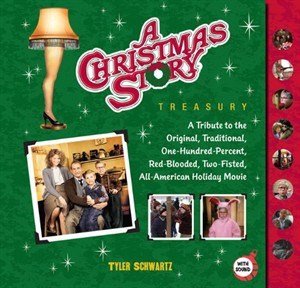
"A Christmas Story Treasury,” which details the Canadian connection to the film “A Christmas Story” by Tyler Schwartz. THE CANADIAN PRESS/ho
December 12, 2013 - 10:22 AM
TORONTO - When the holidays roll around, Oakville, Ont.-based author and entrepreneur Tyler Schwartz likes to display some rather unconventional decorations around his home.
"We do have a leg lamp in every window of our house," he says. "So I guess there's about seven leg lamps on display at Christmastime.
"The first year we did it, the one neighbour next to us ... thought we were running a brothel."
The illuminated gams are actually tributes to the 1983 comedy film "A Christmas Story," in which the patriarch wins a mystery sweepstake prize that turns out to be a fishnet stocking-clad lamp shaped like a woman's leg.
Schwartz details the history of the low-budget film — including its mostly Canadian cast and sets — in the new interactive hard-cover, colour-photo book "A Christmas Story Treasury."
"Here's this modest little movie that, when it was made, I don't think people really thought it was going to go too far — and at first it didn't," says Schwartz, who sells the leg lamps and other holiday movie memorabilia through his website, RetroFestive.ca.
"It took 25 or 30 years to get there, but now it's just a genuine holiday hit that was made in Canada. Not a lot of people know that, and that's what I wanted to highlight in the book."
As the story goes, the film was based on late American radio host Jean Shepherd's short story collection "In God We Trust, All Others Pay Cash," which was inspired by his own family.
Shepherd co-wrote the script with his wife, Leigh Brown, as well as director and co-producer Bob Clark.
Schwartz says Shepherd was known to be "a real grump" while Clark was "much more optimistic."
"But I think that's why it was magical, because it's got a certain part of cynicism and a certain part of optimism in equal measures."
Peter Billingsley stars as Ralphie, the nine-year-old protagonist who longs for a Red Ryder BB Gun despite the ubiquitous warning of "You'll shoot your eye out!"
The setting is 1930s to early '40s Indiana, and some of it was filmed in Cleveland, where the home used for exterior shots in the movie has been restored and turned into "A Christmas Story" House & Museum.
But as Schwartz explains in his book, the majority of the film was shot in Canada with a largely Canuck crew.
That wintry scene in which Flick accepts a "triple dog dare" challenge and gets his tongue stuck to a metal pole? It was shot at Victoria Public School in St. Catharines, Ont.
Or the alley where bully Scut Farkus intimidates Ralphie and little brother Randy (Ian Petrella)? That's from Toronto's east end.
In fact, a lot of Toronto is in the film — from its old streetcars to a restaurant posing as the Chop Suey Palace and a soundstage, where the scenes inside the Parker family home were shot.
"This really is something that Canadians should be proud of, as a product of Canada," says Schwartz, who interviewed dozens of actors and Canadian crew members for the book.
Among those who were interviewed by Schwartz was Martin Malivoire, who made the leg lamps for the film and had them later destroyed because he didn't realize they would become a cherished item. Today, there are no original leg lamps from the film, only replicas.
Schwartz is also director of Canadian operations for the "Christmas Story" museum in Cleveland and made the documentary "Road Trip for Ralphie."
He says he first saw the film on TV when he was about eight or nine years old in the late '80s and fell in love. He's since seen it "hundreds, literally hundreds" of times.
With its "timeless" scenes and "genuine heart," the film is "accessible" and relatable to many, says Schwartz.
Yet film studios weren't interested in the project until Clark directed "Porky's." When it hit theatres, it got mixed reviews and slow box office returns.
"I think at the time, in the early '80s, it was to some people a little offputting," says Schwartz.
"It was just kind of too weird. Today that's softened a bit, because we're used to offbeat stuff, but back in the '80s it was literally considered black humour.'"
The film went on to win two Genie Awards and develop a cult following. It also spawned a sequel and a stage musical that hit Broadway.
Schwartz says he hopes there will never be a remake.
"Because so much of it is kind of ineffable. You can't even really put your finger on why it's so great. But I think most people who see it would agree that it's a neat, magical little movie."
News from © The Canadian Press, 2013